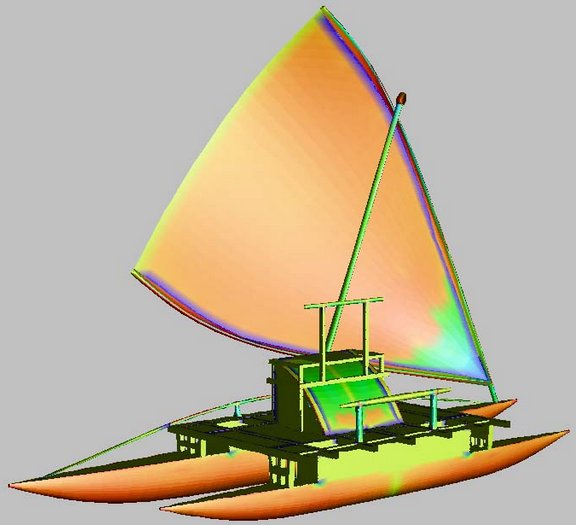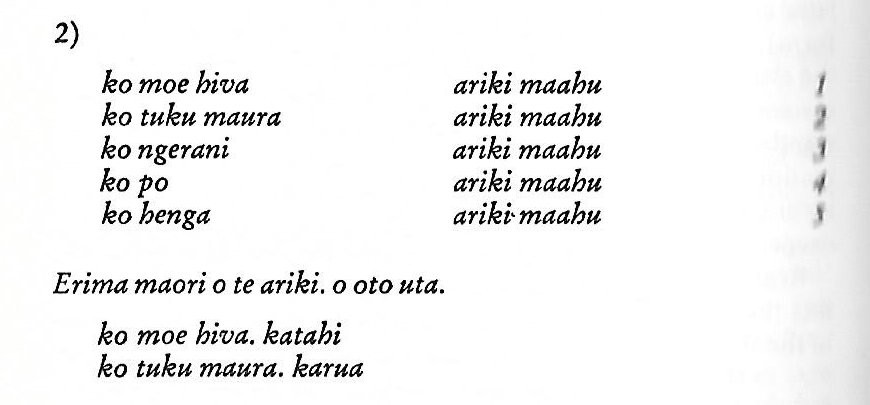|
E:2 |
|
ko moe hiva |
ariki maahu |
1 |
The brothers of the first ruler (? ariki maahu) were Moe Hiva, Tuku Maura, Ngerani, Po, and Henga. |
|
ko tuku maura |
ariki maahu |
2 |
|
ko ngerani |
ariki maahu |
3 |
|
ko po |
ariki maahu |
4 |
|
ko henga |
ariki maahu |
5 |
| Erima maori o te ariki. o oto uta. |
King Oto Uta had five masters (maori): |
|
ko moe hiva.katahi |
the first one was Moe Hiva; |
|
ko tuku maura.karua |
the second one was Tuku Maura; |
|
ko ngerani.katoru |
the third one was Ngerani; |
|
ko po.kahā |
the fourth one was Po; |
|
ko henga.karima |
and the fifth one, Henga. |
| ko moe hiva. te maori i haiteite vai kava te kumi te kumi. o te vai kava. ka peipei rō |
Moe Hiva was the master who taught knowledge of the ocean, who knew about the entire width of the ocean, clear up to where it ends (?). |
| ko tuku maura.katahi. ko ngerani. karua.ko po. |
Of the four masters who instructed in the knowledge of the sun, the moon, the stars, and the sky, Tuku Maura was the first one, Ngerani, the second one; Po, the third one, and Henga, the fourth one. |
| katoru.ko henga.kaha. |
| Ehu maori.i haiteite raa.i te mahina(a).i te |
| hetuu.i te rangi. |
Here we should first notice that Barthel has inserted knew knowledge for us, viz. that the enumerated ariki maahu were the five brothers of king Oto Uta.
Next we learn of the separate character of Moe Hiva - the master who instructed (te maori i haiteite) in the knowledge of the ocean - in contrast to the following 4 brothers who taught about the sun, the moon, the stars, and the sky.
This makes me remember a sequence of 12 glyphs (equal to the number of full stop signs in the last 4 lines above) in the Tahua (A) text:
| e ia toa tauuru - ehu |
e ia toa tauuru - ehu |
e ia toa tauuru - no te uru nuku |
e ia toa tauuru |
e tauru papagete |
 |
 |
 |
 |
 |
| Aa1-37 |
Aa1-38 |
Aa1-39 |
Aa1-40 |
Aa1-41 |
| e ia toa tauuruuru raaraa |
e ia toa tauuru |
 |
 |
 |
| Aa1-42 |
Aa1-43 |
Aa1-44 |
| i te fenua - e ia toa tauuru - ma te hokohuki - e ika no te tagata |
ma te tauuru ki te ragi |
e tauuru no te henua |
 |
 |
 |
 |
| Aa1-45 |
Aa1-46 |
Aa1-47 |
Aa1-48 |
|
Mercury |
Jupiter |
Venus |
Saturn |
Sun |
Moon |
Mars |
|
1 |
2 |
3 |
4 |
5 |
6 |
7 |
|
8 |
9 |
10 |
11 |
12 |
13 |
14 |
|
15 |
16 |
17 |
18 |
19 |
20 |
21 |
|
22 |
23 |
24 |
25 |
26 |
27 |
28 |
|
Wednesday |
Thursday |
Friday |
Saturday |
Sunday |
Monday |
Tuesday |
|
29 |
30 |
31 |
32 |
33 |
34 |
35 |
|
36 |
37 |
38 |
39 |
40 |
41 |
42 |
|
43 |
44 |
45 |
46 |
47 |
48 |
49 |
Ehu means ashes (and similar) and this word occurs both as a characteristic of the 4 ariki maahu who instructed in celestial knowledge and also as a comment by Metoro Tau'a Ure to Bishop Jaussen on Tahiti at what I have understood to be a pair of glyphs at beginning of the season after the Sun had gone down (in the evening or in autumn).
In Churchill 2 we find (item 272) an extensive survey covering several variants of Polynesian words incorporating the fundamental ehu:
| |
dust |
ashes |
vapor |
darkness |
twilight |
muddy |
| Samoa |
efu |
lefu |
|
nefu |
|
nefu |
| Tonga |
efu |
efu |
|
nefu |
nefu |
ehu |
| Niuē |
efu |
efu |
lefu |
|
|
|
| Uvea |
efu, nefu |
efu, lefu |
nefu |
nefu |
|
nefu |
| Futuna |
efu |
lefu |
|
nefu |
|
|
| Nukuoro |
rehu |
lefu |
|
|
|
|
| Maori |
nehu |
rehu |
ehu, nehu, rehu |
rehu, nehu |
|
ehu |
| Moriori |
|
rehu |
|
|
|
|
| Tahiti |
rehu |
rehu |
|
|
rehu |
ehu |
| Marquesas |
ehu |
ehu |
|
|
ehu |
|
| Rarotonga |
|
reu |
|
reu |
|
|
| Mangareva |
ehu, neu |
ehu, rehu |
|
|
|
|
| Hawaii |
ehu |
lehu |
ehu |
ehu, lehu |
|
|
|
A central ceremonial ground was sometimes termed raaraa (raa doubled), which could be a fitting comment on the hour of midnight.
'... The chief thus makes his appearance at Lakeba from the sea, as a stranger to the land. Disembarking at the capital village of Tubou, he is led first to the chiefly house (vale levu) and next day to the central ceremonial ground (raaraa) of the island ...' (Islands of History)
And the element at right in Aa1-47 exhibits the sign for the Sky (ragi):
The new chief comes ashore (makes landfall) after a journey across the sea. Moe Hiva was an expert on matters of the Sea.
There were 5 ariki maahu and in the parallel texts on the H, P, and Q text we can find what seems to be a double-canoe in the place corresponding to Aa1-45. A canoe was like a little floating island according to Polynesian thought - which could have motivated the change from henua to fenua in order to show this special kind of 'land'.
... A canoe (a ship) floated upon the sea like a piece of land: ... 4 March 1779. The British ships are again at Kaua'i, their last days in the islands, some thirteen months since their initial visit. A number of Hawaiian men come on board and under the direction of their women, who remain alongside in the canoes, the men deposit navel cords of newborn children in cracks of the ships' decks (Beaglehole 1967:1225). For an analogous behavior observed by the missionary Fison on the Polynesian island of Rotuma, see Frazer (1911, 1:184). Hawaiians are connected to ancestors (auumakua), as well as to living kinsmen and descendants, by several cords emanating from various parts of the body but alike called piko, 'umbilical cord'. In this connection, Mrs. Pukui discusses the incident at Kaua'i ... I have seen many old people with small containers for the umbilical cords ... One grandmother took the cords of her four grandchildren and dropped them into Alenuihaha channel. 'I want my granddaughters to travel across the sea!' she told me. Mrs. Pukui believes that the story of women hiding their babies' pikos in Captain Cook's ship is probably true ...
 |
 |
 |
 |
 |
| Aa1-45 |
Ha5-46 |
Pa5-28 |
Pa5-29 |
Qa5-37 |
| 145 = 5 * 29 |








